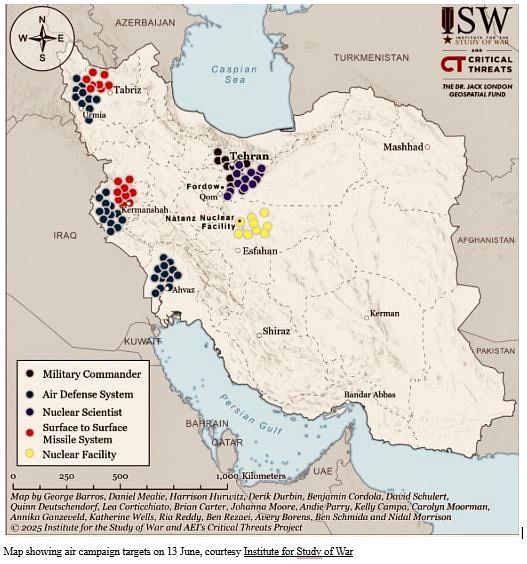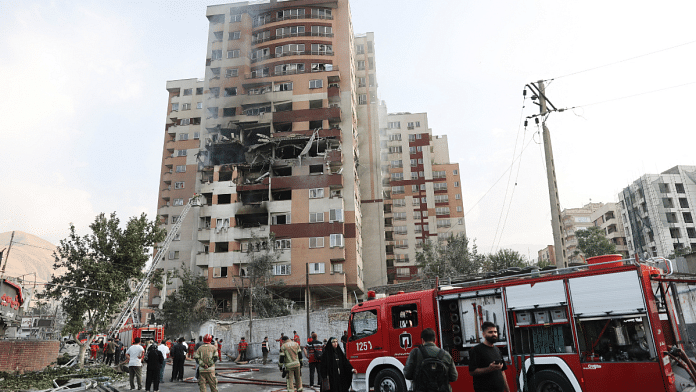On 13 June, starting at 05:30 hours (03:30 Iran time), Israel preemptively launched a series of air strikes on Iran, targeting its nuclear programme, military and scientific leadership, air defences, ballistic missile infrastructure, and other military targets. It was a stunning demonstration of air power at a distance of 1500 km, deploying 200 aircraft using 330 munitions to hit 100 targets without incurring any losses.
The operation was supported by drones fired from a covert drone base to target air defence systems, ballistic missiles likely to be used for counter strikes on Israel, and military/scientific leadership.
The conflict is ongoing, and it is too early to speculate on the final outcome. While the initial aim is very clear—to cripple Iran’s nuclear weapon development programme along with its delivery systems—the long-term objective, seems to be a regime change.
I will only focus on the military aspects of the first six days of the air campaign and the lessons for India.
Operation Rising Lion – a spectacular beginning
Day 1 of Operation Rising Lion has already cut a niche for itself in military history. There was no ambiguity about the political and military aims. Israel’s Prime Minister BenjaminNetanyahu publicly spelled out the political aim an hour after the operation began. “Moments ago, Israel launched Operation Rising Lion, a targeted military operation to roll back the Iranian threat to Israel’s very survival ( implying the nuclear threat ). This operation will continue for as many days as it takes to remove this threat.”
The military aim of the air campaign is to degrade or destroy Iran’s nuclear weapon programme—whether it is uranium enrichment plants, research centres, delivery means, or nuclear scientists/leadership. And in doing so, also target Iran’s response capability for attacking Israel.
Netanyahu summed it up in his address to the nation—“Israel will never allow those who call for our annihilation to develop the means to achieve that goal. Tonight, Israel backs those words with action.”
The first six days of the campaign have been a spectacular success. Sophisticated real-time Intelligence Surveillance and Reconnaissance and Mossad’s deep penetration of Iran enabled precise targeting—right down to the locations of the military leadership and nuclear scientists. Surprise was achieved either through deception by design or with tacit support from the US, as Iran thought that an attack was unlikely while nuclear deal negotiations were underway.
Drones launched from covert base/bases not only targeted the air defence systems, ballistic missile sites, and military/scientific leadership, but also acted as decoys, drawing attention away from air strikes from the west using standoff air-to-ground missiles. Destruction of Iran’s air defence systems was an intrinsic part of the air campaign, and air superiority was achieved by Israel in 48 hours. Almost simultaneously, strikes hit the nuclear infrastructure, ballistic missile sites, depots, factories, military and scientific leadership, and command and control centres.

Details have not yet emerged about damage assessment, but both Israeli claims and satellite evidence indicate that most targets have been hit accurately and substantial damage has been caused. At least 11 Iranian senior military officers, including chiefs of armed forces and Islamic Revolutionary Guards Corps, and nine nuclear scientists/academics, have been killed. Most of these leaders were associated with the “weapons group” formed to fast-track the production of nuclear weapons. The political leadership has so far been spared, but they may be targeted if conditions for regime change are created.
Air attacks have continued over the last six days. Israel’s target list has been expanded to include energy and military industrial infrastructure. Iran’s draconian internal security and social control organisations have also been targeted to prepare for a possible regime change. Nuclear installations have repeatedly been targeted to destroy the support infrastructure and the hardened underground sites. Severe damage has been caused to key Iranian nuclear weapon-related sites, except the critical Fordow fuel enrichment plant, which is buried deep into the mountains out of reach of Israel’s deep strike capability.
Iran’s response capability in terms of ballistic missiles and drones has been severely degraded by the air campaign. It is estimated that 50 per cent of ballistic missile launchers and 35-40 per cent of the missile stockpile have been destroyed. Iran has launched approximately 450 ballistic missiles, out of which only 5-8 per cent penetrated Israel’s air defence.
Also read: A rejuvenated Pakistan likely to collude with China, plan a conflict with India in 5-10 years
Lessons for India
Israel has once again proved that it has a clear national security strategy and has always maintained the desired military capability to deter its multiple adversaries simultaneously. India too needs to formalise its national security strategy and transform its military to create a capability for ‘dissuasive deterrence’—deterrence by denial—against China and ‘offensive deterrence’—deterrence by punishment—against Pakistan. It must be prepared for a conflict or war when deterrence fails and when both are in collusion. As per my assessment, India’s current capability is just 50-60 per cent of what is desirable.
Like Israel, India must also bring clarity to its political and military aims for conflict or war. For Operation Sindoor, the declared political aim had ambiguously focused on punishing the terrorists and their backers (implying Pakistan’s military). Unfortunately, the military parroted the same. The more logical political aim should have been to force compellence on Pakistan, while the military aim should have focused on executing controlled, escalatory operations below the nuclear threshold to impose a psychological defeat on Pakistan.
Lack of clarity in political and military aims led to the costly mistake of only focusing on terrorist hubs on the night of 6 and 7 May, without first or at least near simultaneously conducting counter-air operations, of which suppression of air defences is the sine qua non. The result was the loss of an unspecified number of fighter aircraft—allowing Pakistan to claim victory and parity in the conflict. The basic tenets of military operations cannot be ignored in any conflict.
India requires a much deeper intelligence penetration of its adversary countries, as the Mossad has done in Iran. Imagine the impact of our air and drone strikes if we had eliminated the top rung of terrorist leadership in Pakistan, instead of destroying empty buildings in terrorist hubs after giving 15 days’ notice.
India needs to keep its options open for a preemptive or preventive operational strategy to achieve surprise. And if forced to react, it must be done within 24-48 hours.
Air power and Unmanned Aerial Systems (UAS) are going to play a predominant— and, in India’s context, preeminent—role in future conflicts and war. China is already fielding two fifth-generation fighter jets—J-20 and J-35—and Pakistan may soon acquire 40 J-35s and possibly, also the Turkish KAAN. India’s Advanced Medium Combat Aircraft (AMCA) is still under development and unlikely to be inducted before 2035. Apart from the stealth features, the J-35’s PL17 air-to-air missile with a range of 400 km will out-range all other similar missiles. India will have to give serious thought to acquiring a fifth-generation fighter and upgrading the AMCA to a sixth-generation fighter. Similarly, the Indian Air Force cannot afford to be out-ranged by the adversary’s air-to-air missiles.
The exploitation of UAS in Operation Sindoor was only 25-30 per cent of what will unfold in future operations. Operation Rising Lion and Operation Spider’s Web, and the war in Ukraine, have demonstrated that UAS will play a major role in modern wars. It is a cost-effective technology that must not be ignored and can offset investment in other costly weapon systems.
Air defence is now an intrinsic part of air power, both for offensive and defensive operations. Look at the air superiority established by Israel by suppressing Iran’s air defence and the effectiveness of its own air defence in safeguarding itself against ballistic missiles and drone attacks. There is no choice for India but to create an elaborate air defence network to shield its critical assets and also complement counter-air operations in the adversary’s territory.
Surface-to-surface long-range missiles will also play a major role in the future. Nuclear thresholds have imposed caution on the use of ballistic missiles, but it may not be so going forward. Despite all odds, Iran continues to target Israel with ballistic missiles. This is one field in which India has the expertise to create an arsenal out of reach of Pakistan and match China.
Electronic and cyber warfare can neutralise most modern weapon systems and precision-guided munitions. No modern army can do without this force multiplier, which will be omnipresent in all facets of the battlefield.
Operation Rising Lion has certainly set new benchmarks for future wars. While India’s strategic environment is very different than that of Israel, the lessons that have emerged must be imbibed for the immediate modernisation and long-term transformation of the armed forces.
Lt Gen H S Panag PVSM, AVSM (R) served in the Indian Army for 40 years. He was GOC in C Northern Command and Central Command. Post retirement, he was Member of Armed Forces Tribunal. Views are personal.
(Edited by Ratan Priya)





Panag, stop behaving like a vexed child. We have other bigger things to deal with. India is already wasting too much money on defence sector. Defence should be put on back burner. Defence is a trap. We should focus on our economy.
You are not going to get an RS Ticket.